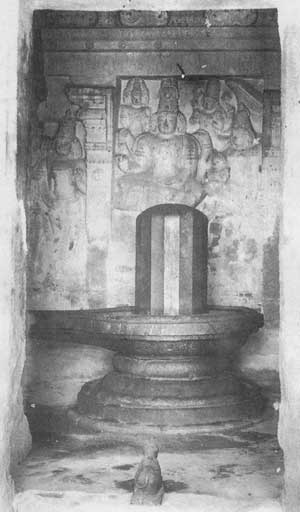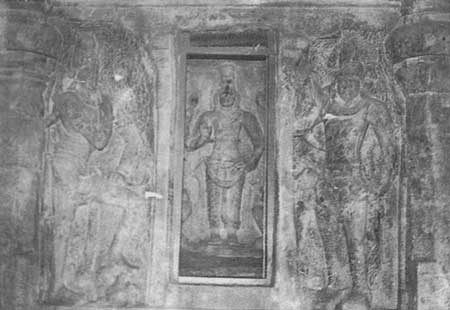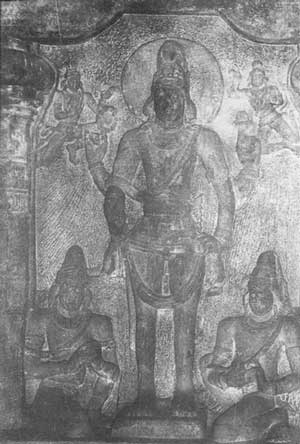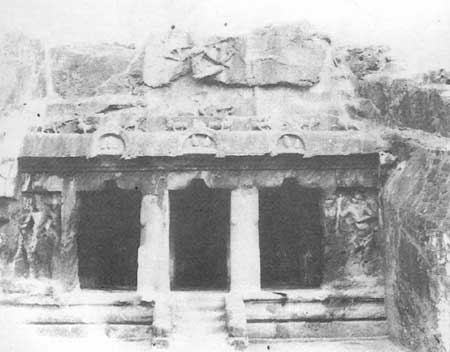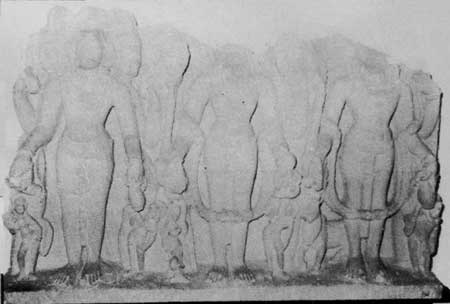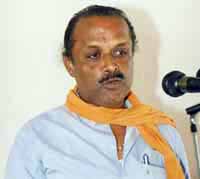
|
|||||||||||||
|
| |||||||||||||
Trimurti Orientation in Medieval South Indian Templesby Raju KalidosEtad anistakam adrumam aloham asudham ‘This brickless, timberless, metalless and mortarless mansion (i.e. temple) The Mandagappattu inscription of the Pallava king, Mahendravarman I (ca. AD 610-30), is outspoken in declaring that temples for the Hindu Trinity (i.e. Brahmeśvara Visnu), were erected during the early medieval period of which there are several examples, both in the Deccan and the Far South.[1] The Mandagappattu cave temple itself consists of three cellae (garbhagrha-s) that are empty now but likely to have enshrined images of Brahmā, Śiva and Visnu. The Trimūrti-mandapa of Māmallapuram is a good example wherein figurative representations of the three gods as bas relief-s occupy the back wall of the cave. In the Krishna delta there are examples among the Moghulrājapuram and Vijayawāda groups of rock-cut cave temples. All were intended for the Trinity though the caves at present are devoid of any iconographical illustration. There are also few iconographical forms of the medieval times (e.g. Trimūrti of the Elephanta type, Somāskandamūrti and Ekapādamūrti), which purport to illustrate a syncretistic form of the Trinity. That means at a particular point of time in South Indian iconographical tradition, Trimūrti was popularly cult-oriented. Later, the cult seems to have fallen into oblivion as images of Brahmā are not to be found enshrined under the roof of a garbhagrha due to the mythological version that Brahmā was not to be adored as housed in temples.[2] So, during the later medieval period (say, after AD 850), it appears that temples for the Trimūrti were rare. Interestingly enough, there were few examples of the Kākatiyas and Hoysalas in Andhradeśa and Karnātaka. The Kākatiya temples are to be found in and around Warrangal, the metropolis of the kingdom. Of the Hoysala temples, the best examples are Trikūteśvara at Gorūr, Mallikārjuna at Basurālu and Harihareśvara at Harihar (Settar 1992: 193, 196, 210). These temples are in trikūta pattern as it is the case with the Tirupparankunram south cave (Kalidos 1991: fig. 1. cf. Rajarajan 1991: figs.1-3, 6). The later medieval traditions as followed by the Kākatiyas and Hoysalas disregard Brahmā and introduce Sūrya and others.
IOf the Trimūrti cave temples of the early medieval period, the Mandagappattu cave and Trimūrti-mandapa of Māmallapuram are important. The dedication of the three cellae in Mandagappattu to the Trimūrti-s could not be disputed in view of the epigraphical evidence (supra). The absence of iconographical representations is not a matter to reckon with because many of the caves had painted figures of divinities on the back walls of the caves (Śrīnivasan 1972:42). In case of Mandagappattu, still the remnants of paintings of the three gods are found.[4] The Trimūrti-mandapa is a solid case in consideration to establish the point that the Trimūrti-s were housed in the cellae. Its middle cella houses an image of sthānaka-Śiva in the back wall. To the left sthānaka-Visnu appears in the cella and Brahmā to the right. Some would consider the latter as Brahmasāsta (Dubreuil 1914:49, Śrīnivasan 1964: 159).[5] This is a form in which features of Brahmā and Skanda find a harmonious blend. The Mahisāsuramardinī-mandapa of Māmallapuram is also tri-cellar, enshrining a linga in the middle cella and an image of Somāskanda on its back wall (Fig. 76 at right), In this case, the other two cellae are empty but are likely to have housed images of Brahmā and Visnu. Visnu in this case is likely to have appeared in the right cella since an image of Śesaśāyi appears on the lateral wall (cf. infra fn. 13).
Another important cave temple deep in the interior is the lower cave at Tiruccirāppalli. Actually, there are only two cellae, facing each other in the east-west order. The east facing cella is meant for Śiva and west facing one for Visnu as his image in sthānaka aspect appears (Fig. 77 at left). The back wall of the cave provides for five niches housing images of Ganapati, Śiva, Brahmā, Sūrya-Nārāyana (Fig. 78 at right) and Mahisāsura-mardinī, all in sthānakā aspect. The central niche is occupied by Brahmā who grouped with Śiva and Sūrya-Nārāyana constitute the Trimūrti-s. If the niche could be counted on par with a cella, it would appear that Brahmā here occupies the pivotal place. Besides, the union of Trimūrti-s within a panel is also an early medieval idea as they are to be found again in the Deccan. In cave XVI (the Kailāsa) of Ellora, the right subsidiary cave, called Lankeśvara, houses the Trimūrti-s on its back wall with Śiva in centre, Brahmā and Visnu to the right and left respectively. Cave XXVII of Ellora, called the Milkmaids, houses a panel akin to the Lankeśvara representation of the Trimūrti-s but Visnu occupies the central place with Śiva and Brahmā to his left and right respectively. At Bādāmi, the Western Cālukya metropolis, there is a stray carving on a boulder, close to the Bhātanātha temple. There is also a stray slab in the Mahakuteśvara temple complex at Mahākūta. These two specimens are in imitation of the Lankeśvara mode. On this basis, it may be hypothesized that the Tiruccirāppalli lower cave also represents the Trimūrti-s with Brahmā in centre, thus falling in line with a pan-Indian mode. There is also a possibility of isolating Brahmā in this group. If Ganapati and Śiva are linked with the cave for Śiva, and Sūrya-Nārāyana and Mahisāsuramardinī linked with the cave for Visnu, then Brahmā stands alone. That means there is a case to treat the niche itself as a cella for him in which case the organisation of the cave temple would be trikūta.
The Tirupparankunram south cave consists basically of three cellae, two on the lateral and the main, dedicated to Mahisāsuramardinī, on the back wall. The lateral shrines are dedicated to Linga-Somāskanda (east facing) and VisnuVaikunthamūrti (west facing) (Kalidos 1991:267-68).[6] Devī-Mahisāsuramardinī is of the Tamil type who does not slay the zoomorphic mahisa as in the Deccan but stands on the decapitated buffalo head.[7] Here Brahmā is replaced by Devī.
Cave II of Moghulrājapuram provides clues for identification of the cave vis a vis their original dedication. Atop the rock in which the cave is cut, an image of Natarāja performing ūrdhvajānu appears. The facade in its cornice provides for kūdu-s which appear on a line with the dvāra-s of the triple cellae. Within the kūdu-s images of the gods in bust form appear (Fig.79-A). They are (1) trimukha = Brahmā, (2) Śiva and Devī, and (3) Visnu and Laksmi (Soundararajan 1981:Pi. CXVI). These clues would enable the identification of the original dedication of the cellae, of which the middle was for Śiva, the right one for Brahmā and the left for Visnu. Basing on this evidence, it may be generalized that the other tricellar caves in Moghulrajapuram (No. 1) and Vijayawāda (Akkanna-Mādanna) were also for the Trimūrti-s. The Mandagappattu and Māmallapuram rock-cut caves are dated in the early 7th century AD, assigned to Mahendravarman phase (Śrīnivasan: 1964). K.V. Soundararajan (1981: 9) assigns the caves in the Krsnā basin to the middle of the 7th century AD. Evidences of Trimūrti images in the Upper Deccan (e.g. Ellora mūlabera-s) and Lower Deccan (e.g. Bādāmi and Mahākūta) are dated in the post-Mandagappattu phase. So, it is likely that Mandagappattu was a pioneer in this regard. From this starting point, the cult and a type of temple, i.e. trikūtācala, designed for the purpose reach the acme under the Kākatiyas and Hoysalas. An evolutionary process is traceable from the early medieval to the later medieval periods in which the early ideas played a vital role. IIProfessor M. Rama Rao's (1966:105-11) documentation of Kākatiya temples accounts for not less than four of the trikūta pattern,[8] from out of a total fifty-three temples, stand significantly. They are found at Hanumakonda, Pālampeta (Warrangal district), Panagai and Pillalamarri (Nelgonda district).[9] Built in the l2th-l3th centuries AD, the vimāna-s of the Panagal temple are of the Kadambanagara type. Others, excepting the walled cellae, are devoid of Vimāna-s.[10] The fact of the tri-cellar shrines is that the womb houses face the east (for Śiva), west (for Sūrya) and south (for Sūrya-Nārāyana). This generalization is based on the evidence provided by the Hanumakonda temple while in case of others, it is not possible. The Chaya-Someśvara temple at Panagal houses the Linga in its east facing cella. The unity of the pattern of arrangement in respect of the location of cellae is altered in the Pillalamarri temple wherein the west facing cella is missing and instead there is one on the south, facing north. The common factor is that there are three cellae, dedicated to three Mūrti-s. The sophisticated among trikūtācala are to be found among the Hoysala monuments. The orientation of deities varies according to the principal dedication. Thus, in case of temples for Visnu, different forms of the Lord are housed in the cellae. These are usually Venugopāla (south cella), Purusottama or Keśava or Janārdana or Nārāyana or Mādhava or Śrīdhara or Harihara (middle cella) and Laksmīnrsimha, Yoganrsimha or Janārdana or Anantapadmanābha (north cella). (Settar 1992:191-92). In case of temples for Śiva, the Linga occupies one or two and the third by a form of Visnu or Devī (see Settar 1992:193-94). Of the eleven solid examples of Trimūrti rock-cut cave temples of the early medieval period, two are actually in the trikūta pattern. They are Tiruccirāppalli and Tirupparankunram. In all other cases, the cellae are in a row, fitted against the back wall of the cave. So, it may be pointed out that the trikūta pattern has its roots in the early medieval traditions of which the Pāndya temple at Madurai is one of the finest examples. The Cālukyas, both Western and Eastern, do not provide for cellae on the lateral sides.[11] It is this pattern which in Kākatiya and Hoysala temples develops into trikūta. In this form the basis is a triangle the summits of which are occupied by the Trimūrti-s. Basically one, only on functional grounds the Trinity separates as it is symbolically pointed out by the Ekapādamūrti type of icon of which a good example is found in the shore temple at Māmallapuram (Kalidos 1988-b: 215). A significant development under the Kākatiyas is that Sūrya replaces Brahmā. Neither Sūrya nor Sūrya-Nārāyana find a place among the Hoysala temples. The problem with the Kākatiya mode is whether Brahmā could be replaced by Sūrya. It seems, it is possible. According to the Śāradātilaka, quoted in Śrītatvanidhi (II,5:2), there is a form of polycephalous Sūrya, called Caturvaktra-Sūrya. He is endowed with astabhuja-s; holding the khatvānga, padma, cakra, śakti, pāśa, ankuśa, japamālā and kapūla. He is trinetra and attended by his wives, Chāyā and Usā. He wears the sakalābharana-s, including ratna krita and ornaments inlaid with diamonds and has the body shining like gold. What is important in this form is that the laksana-s, characteristic of Sūrya (padma), Brahmā (aksamālā), Visnu (cakra) and Śiva (khatvanga and kapāla) merge into an entity to constitute the four-faced Sun-God. So, this aspect of Sūrya is viewed as an amśa of several gods of whom one is Brahmā. Now, there is a pretext to view Sūrya as an amśa of Brahmā. Maybe such factors moulded the placement of Sūrya in Kākatiya temples, replacing Brahmā of an early tradition. Furthermore, the mythological stigma that an image of Brahmā should not occupy the cella was also a factor behind the ejection of the Lord from the core temple. The ejection of Brahmā from the temple core is likely to have taken place around the 8th century AD. The Tirupparankunram north group of caves provides clues towards this end. The original cave here was for Śiva and Visnu (Rajarajan 1991: fig.4). During the reign of Varaguna Pāndya (AD 767-815) some alterations and additions were made to the original rock-cut temple in the Kali year 3,874 (AD 773-4). The addition was a separate cella for Devī in which place we find Brahmā in the Tiruccirāppalli cave. It is a naive pointer to the fact that Brahmā was taken out of the core temple. In case of the Tirupparankunram cave temple, he is assigned a place, just above the pranāla, meant for the chamber of Śiva (Rajarajan 1991: fig. 3). In the Cola temples, later, Brahmā sticks to his place in the devakostha which appears above the pranāla.[12] Devī taking the place of Brahmā is important in the sense that a feminine form of godhood occupies the place of a male form. We may also suggest the case of a parallelism in respect of the cella for Brahmā and an image of the Goddess in Mahisāsuramardinī form (in case of the Tirupparankunram cave also it is Mahisāsuramardinī who stands on the decapitated head of mahisa) who appears on the side wall, coeval with Śesaśāyi.[13] Again, in the Elephanta type of Trimūrti the left face in profile, representing Brahmā, is feminine in some cases. He being the Hirnyagarbha, perhaps a feminine character would have been an accepted norm.[14] Sūrya as an amśa of Brahmā seems to be shown in the Tiruccirāppalli lower cave also (Śrīnivasan 1972:52). The image of Sūrya-Nārāyana in this case holds the aksamālā in its right para hasta, thereby suggesting a case for the union of Sūrya, Visnu and Brahmā. All these points would allow us to generalize that the replacement of Brahmā by Sūrya was already a regulated idea. The Kākatiyas added solid dimension to the tradition by accommodating such a form in their temples. According to the standard set by them, the Trimūrti-s were Śiva, Sūrya and Visnu. There are some internal evidence in the Kākatiya temples to prove the idea. There are few miniature reliefs in the Kākatiya temples. The 1,000- pillared temple of Hanumakopla on the lintel of the door frame of the Visnu shrine consists of a representation of Trimūrti-s who are Śiva as Natarāja, the trimukha-Brahmā and Visnu (Nigam 1980:93). Image carvings at such a location in the Hindu temple are supposed to indicate the dedication of a garbhagrha to the deity illustrated. This is to prove that the Kākatiya temples are basically dedicated to the Trimūrti though actually one of the cellae houses an image of Sūrya in place of Brahmā.
About the 7th century AD all three members of the Hindu Trinity held a status of primus interpares. This is proved by the iconographic models in which the three appear in a panel. Brahma is in centre in the Tiruccirāppalli lower cave. Śiva occupies the centre in Lankeśvara of Ellora. Visnu takes the central position in the Milkmaids cave of Ellora. After the 8th century AD Brahma gets out of the picture and it is either Śiva or Visnu who gets priority. This trend continued up to late medieval times as is proved by a panel of Trimūrti relief found in the Lucknow Museum. In this case, it is Visnu who is in centre, thus falling in line with Milkmaids cave representation (Fig.79-B). To sum up, the Trimūrti cult had a sway over South Indian temples during the 7th century AD. There were three ways by which the cult was perpetuated: (1) having images of the three gods in three separate cellae; (2) representing the deities in three separate forms but falling within a bigger frame (e.g. the Lankeśvara of Ellora and Lucknow Museum piece), and (3) giving shape to syncretic iconographical forms (e.g. Ekapādamūrti, Lingodbhava and Somāskanda). The tradition of placing the Trimūrti in separate cellae continued up to the Kākatiya time. They also introduced some innovations by replacing Brahmā with Sūrya. The Hoysalas took to different modes of representation. Both the Kākatiya and Hoysala added significantly in the history of south Indian temple architecture by giving shape to trikūtācala types of which the masterpieces are to be found deep in Karnātaka. Thus, from the 7th to the 14th century AD an age stands after the Trimūrti cult in south India which was popularized by the temple layout and the programme of iconographs. References
End Notes[1] The following rock-cut caves of the Pallavas are tricellar: Rudravāliśvaram (Cave II) of Māmandūr, Kalmandapam of Kuranganimuttam, and the following mandapa-s of Māmallapuram: Dharmarāja-, Mahisāsuramardinī-, and Trimūrti-. In the Pāndyan zone, Tirupparankunram north is a good example. Of the Deccan caves, those in the Krsnā delta (e.g. Akkann-Mādanna of Vijayawāda and caves I and II of Moghulrājapuram) are notable. Though there is an array of caves in Ellora nothing significant is to be found, barring few exceptions among the Ganeś-lena group. The Bhokardan cave is of seven cellae as is the case with Vilappākkam in the Pallava zone. [2] The Linga-, Kūrama-, Vāyu- and Śiva Purāna-s associate this episode with the falsehood uttered by Brahmā when he with Visnu attempted to scale the inaccessible Linga (Rao 1985:107). [3] References to Kākatiya temples are based on Professor Rama Rao's book. The references to Hoysala temples are based on Professor Settar's masterpiece. The author has visited Hanumakonda and the Hoysala temples at Halebid and Belur. He is familiar with the Hindu caves of the early medieval period, most of them visited not less than ten times. A small report on the ruins of Warrangal was also published (Kalidos 1990). [4] For authentic evidences one may turn to the devakulikā-s of the Kailāsanātha temple at Kāikipuram wherein paintings of Somāskandamūrti are still intact. The peculiar pattern with Pallava Somāskandamūrti is that images of Brahmā and Visnu appear behind the face of Śiva. Examples maybe found in the Mahisāsuramardinī-mandapa and Shore temple (east and west facing cellae). During the discussion hour, an ill-informed student of art who is Curator of the Pudukkōttai museum disputed this point. He said there is no such motif in Pallava art. See (Fig.76). [5] According to Śivaramamūrti (1972), it is Brahmā. [6] For a recent interpretation of the Tirupparankunram caves see Kalidos (1991 & 1993) and Rārajan (1991). [7] Usually, called Durgā, the Goddess represents Mahisāsuramardinī who stands in a benign attitude after having cut the head of the turbulent buffalo (Kalidos 1989:748). [8] The term is defined as "three Vimāna-s either arranged in a line or placed around a common hall" (Prasad 1980:222). The word, kūta, gives several meanings of which one is "the summit or peak of a mountain". It also means "end" or "corner". The word, kūtāgāra stands for an apartment on the top of an edifice (e.g. the Lad Khān temple at Aihole) (Apte 1976: 157). According to the Amarakośa (vv. 1072, 641), kūta stands for a heap of grains or the summit of a mountain, synonymous with śikhara or śrnga. So, it appears that trikūta stands for triple vimāna-s which are equal to the triple peaks of a cosmic temple, the axis mundi. In the Nāgara type of temples, both rekhā and kadamba, the jagati part of the structure is the bhūmi (or mountain) upon which the prāsāda stands. So, metaphorically the trikūta-s are supposed to be the summit of the World Mountain. It is the case with Khajuraho type of temples. [9] For a recent list see Prasad (1980:173 ff). It includes few more trikūta-s, examples being the Agastyeśvara temple at Malleśvaram (dated in AD 1033), a ruined temple at Nagnuru and another at Pushpagiri (Cuddapah district). [10] That is the superstructure of a temple which stands above the pāda or bhitti ‘wall'. [11] A number of Pāndyan caves provide for cellae on the lateral sides; example being Malaiyakkovil, Tirumeyyam, Malaiyadippatti (Kalidos 1988b: fig.), Tirupparankunram (south cave, Kalidos 1993:fig.), Tirumalai (Rajarajan l992:fig.), Tirumalaipuram and Tirunandikkara. [12] This pattern, i.e. Brahmā appearing above the pranāla, may be found in the Cola temples at Tancāvūr and Tārācuram (Kalidos 1993:fig.). [13] For details see Kalidos (1989:13). [14] For a detailed discussion of the subject see Kalidos (1988a: 423-25).
This article originally appeared in Kalā, the Journal of the Indian Art History Congress, Vol. I (1994-95), pp. 93-102. Dr. Raju Kalidos is Dean of the Arts Faculty and Head of the Department of Sculpture and Art History at the Tamil University, Tanjavur. He has published more than sixty articles on Indian iconography in distinguished academic journals of Europe and India. He has published and lectured extensively on topics of Indian sculpture, architecture and iconography and was voted 'Man of the Year 1997' by the American Biographical Institute. See also "The Iconography of Skanda-Murukan: Flashes of Insight" by Raju Kalidos |
